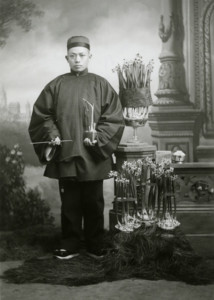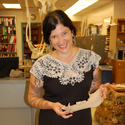Digging Jacksonville – November 2016
During our excavations into the Chinese Quarter, we got a peek into the pantry of a household occupied by Chinese residents in 1888. On the shelves, we found a variety of glass and ceramic tableware that was used to prepare meals, serve food and drinks, and even items brought out for times of celebration. While we all can relate to this suite of household goods, as history sleuths, we are always looking for some of the unique, practical, or inventive ways people expressed themselves through how they use the everyday items in their home. Many of us have turned a vintage bottle or old Mason jar into a flower vase, or filled a pickle jar with nails or buttons. Many of these actions can be invisible a century later, so it is particularly cool when we can get clues about creativity and self-expression from an archaeological excavation into an historic home.
I have chosen two pressed glass items that help us connect with the individual or individuals living on Main Street more than a century ago. Pressed glass tableware came in a variety of forms, and has been a popular table setting for decades. Its earliest incarnation, leaded glass, was modeled after cut crystal, making that coveted tableware more affordable for the average family. During the Civil War, lead was needed in large volume, and the recipe was tweaked—the result was an even less expensive material that could be molded into a variety of intricate patterns and vessel forms. Pressed glass dishes have been recovered from archaeological sites across the region—and I bet most of you have seen the nineteenth century, or the later more colorful twentieth century version called Depression Glass, amongst your family treasures.
Our first featured pressed glass artifact was a goblet embossed with “Happy New Year!” While this goblet was likely created to commemorate the first day of the year according to the Gregorian calendar used in America, the celebratory cup was perhaps repurposed for the February celebrations of the New Year according to the Chinese lunar calendar. These celebrations were, and continue to be, an important part of life in Jacksonville.
We also found several fragments of a pressed glass footed compote, or bowl, with a design known as “Viking,” “Bearded Head,” or “Old Man of the Mountain,” manufactured by Hobbs, Brockunier and Co. circa 1876. These footed bowls were often used to serve compotes (a sugary fruit mixture), however, photographs suggest that this dish might have instead been used to plant narcissus bulbs.

This photograph by Peter Britt shows local business owner Toy Kee with a collection of narcissus bulbs. If you look closely, the bulb cluster on the pedestal is rooted within a pressed glass dish similar to the one we recovered. Photograph courtesy of the Southern Oregon Historical Society.
The popular Narcissus flower (Narcissus tazetta subspecies chinensis) was reportedly referred to as seui sin faa (water immortal flowers), and shipped to Oregon in bulb form where it could be easily rooted in a shallow dish with small pebbles and water. A photograph of local Jacksonville business owner Toy Kee, shows a cluster of narcissus grown for the Chinese New Year in a footed compote bowl similar to the one we recovered.
The presence of these artifacts within the household of a Chinese resident of Jacksonville helps us get a glimpse of the types of items that filled up the homes of community members in the past. Even though both of the above items could have been used as part of the Chinese New Year celebrations, they nonetheless fall within the details of our everyday lives that so often go undocumented. Until the archaeologists come and dig them up, that is!
Featured image: This photograph is a close-up of one the fragments of the Viking footed compote dish found in the Jacksonville Chinese Quarter.

 Chelsea Rose is an historical archaeologist who specializes in the settlement and development of the American West. Chelsea and the Southern Oregon University Laboratory of Anthropology (SOULA) conduct archaeology across Oregon and have done several projects in Jacksonville. You can reach Chelsea at rosec@sou.edu and follow SOULA on
Chelsea Rose is an historical archaeologist who specializes in the settlement and development of the American West. Chelsea and the Southern Oregon University Laboratory of Anthropology (SOULA) conduct archaeology across Oregon and have done several projects in Jacksonville. You can reach Chelsea at rosec@sou.edu and follow SOULA on